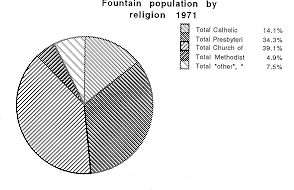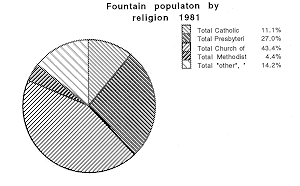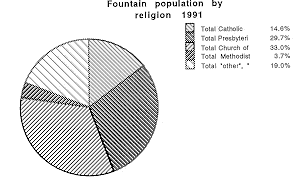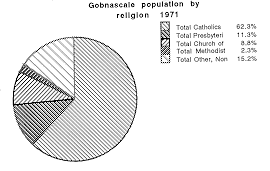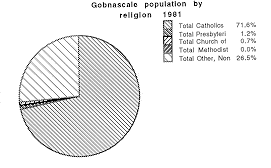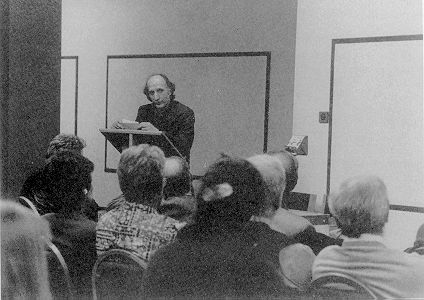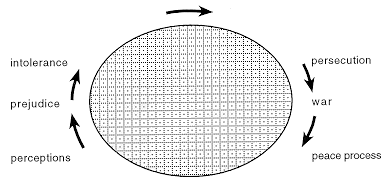Central Library, April 13, 1995.
An excerpt from "Exodus", (a play by Gary Mitchell
from a concept of Roy Arbuckle's) in which the character, "Alice",
a middle aged woman in an overall and holding a brush, muses about
her life. The excerpt was read by Ann Corr.
Some people were put out of their houses. Petrol bombed, threatened.
Some people ran away, frightened. There was a lot of stories.
A lot of lies. A lot of pretending to be victims went on. They
just wanted new houses. Bad things happened. Lives ruined and
wasted, a lot of young lives lost.
This place just, fell apart, really. Ye would hear about the knock
on the door and there's them standing there, cheeky as you like
saying - 'When are you's leaving, we've a family waiting to move
in. Can I see inside? And the rumours and the legends, I still
think about them.
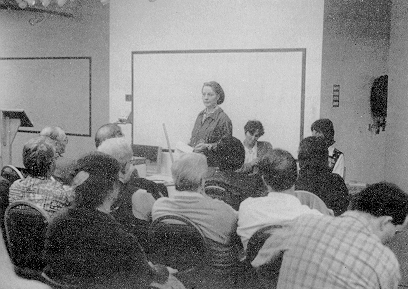
Redevelopment - remember that one. I can't see it happen. People
plucked out of their houses, some had lived in them all their
lives. Up and out. Of course they'll be allowed back. And when
they come back the area will be a better place to live. Better
houses, better streets. And how much would this cost us? - that's
what wee Mrs. Thompson used to complain about. Cost more than
we thought, though, didn't it. Hardly anyone came back. Some said
they were told they didn't meet the requirements for the new houses,
not enough points. There was people worse off, people who needed
houses. Catholics! Was it a plan? Was it a mistake? Or did it
just happen? I don't know. I never asked for a new street. I liked
the streets the way they were - Corporation Street, Barrack Street,
Rosemount- eh? The Glen! Ivy Terrace, the Foyle Road - there was
nothing wrong with these streets. I loved them, playing in them
- well?
I came back. Seen it all. The riots in William Street and the
Bog. The soldiers - the police - the Provos - the bombing - the
shootings. Seen it all, so I did. The barbed wire - my wee nephew
gazing up at me as if the world had fallen apart and he almost
choked as he spoke - 'Your house is burning'. Our house is burning.
It was always in my head, I'm not moving. Too many did. Somewhere
inside something said, stay. And so I did. I love this place.
Means everything - means memories. I'm tired. Getting old now
alright. Still......
I was on a committee. I joined the Defenders. They were trying
to take our land. Take our houses. Take our jobs. Catholics, all
they do is take, take, take. Take the eyes out of your head. Take
the weans if you let them.
Throwing stones one night. All hell broke loose. I had gone out
to make sure our ones were alright. I lifted a few stones and
put them in my pocket - well, you never know. The young tartans
were going mad, like savages. Crazy kids. Stones, bricks, anything.
A little boy's hair and jumper suddenly burst into flames. He
was in charge of preparing the petrol bombs. Something had gone
wrong, it was just an accident. He rolled around on the ground.
I rushed over as fast as I could, but it seemed to take forever.
Everybody thought the fenians did it. There was going to be hell
to pay. And there was. Revenge. I don't know how many young ones
got hurt because of that. Hundreds were beaten up and stuff. The
guns were out.
Something had gone wrong, something had changed. I had changed.
I opened my eyes and seen what was going on. And I didn't like
what I seen. I left the town. Me nerves were wrecked. I got out.
Our young ones were getting a while lot of bother. Trouble was
always just around the corner. Our youngest got a kicking.
So....So here I am, after all these years. Just had to get back
here. I just couldn't resist coming back over. Just wanted to
be in the old place, but it's not here. Just like the people.
All gone. I suppose what I really want to get back is some to
the old feelings. But they're gone and....I really must be going
too.
Alice clears the place up and leaves, slowly.
Templegrove Action Research and University of Ulster Magee College.
Segregation is not new in Ireland but predates the partition of
the island and the creation of the Northern Ireland state: it
therefore also predates the present troubles. The overall balance
in the population between Catholics and Protestants has been a
matter of political interest and concern for both parties, and
the ratio of Protestants to Catholics has not remained constant
in Northern Ireland as whole, as is illustrated in Table 1.
Table 1
Source: Northern Ireland Census: Religion Tables
Some areas of Northern Ireland have been predominantly Catholic
or Protestant over long periods of time, due to a complex of economic,
social and political factors. Within Belfast in the present day,
segregation is very marked, and it is estimated that 50% of the
total population of Northern Ireland live in areas that are 90%
or more Catholic of Protestant. The distribution of segregation
throughout Northern Ireland is illustrated in Table 2.
Within Northern Ireland as a whole, segregation was markedly increased
by the population movement of the early 1970's and has been steadily,
if less dramatically, increasing ever since. This can be seen
in Belfast by examining ward populations by religion, as McKitterick
has done. (see Table 3) The trend of Protestants moving out of
Belfast into the hinterlands of North Down and corresponding moves
in other areas has been referred to as the greening of our cities,
due to the increased proportion of Catholics within cities.
Source: Northern Ireland Census 1991: Religion Tables
Belfast - The Segregated City
** signifies wards which seem to have some degree of integration,
but which are (contd over)
in fact internally segregated, sometimes by peace lines * signifies
those which are on the face of it integrated. Closer inspection
shows, however, that they were once predominantly Protestant but
that Protestants are steadily moving out.
Table 3 Source: McKitterick, David. Apartheid Deepens on the
Streets of Ulster.
The overall trend of population movement over the last twenty
years has been towards increased segregation. At the time the
research began, that same trend - that of Protestants moving out
of the city - had been apparent in Derry Londonderry. A static
picture of the population of the city can be derived from the
1991 census, and we have calculated the percentages of the population
for each denomination in Table 4.
Derry/Londonderry Local Government District Religion by age and sex Extracted from: The NI Census 1991: Religion Reports
From this static picture, we can see that the city was predominantly
Catholic (69.48%) at the point when the 1991 census was taken.
In the context of Northern Ireland, Derry Londonderry has the
second highest percentage of Catholics in the population of any
local government district, the highest being Newry & Mourne.
Derry Londonderry also has the fourth lowest percentage of Presbyterians,
the second lowest percentage of Church of Ireland residents, and
the sixth lowest percentage of Methodists. The total Protestant
population in the city area accounted for 20.85% of the total
population, with 9.67% of the population being of "other"
denominations, "none" or they did not state their religion.
Some of those who are categorised as "other" are undoubtedly
Protestant, so the Protestant percentage of the population is
likely to be somewhat higher than 9.67%. Whilst these figures
tell us about the population balance in 1991, they do not establish
the movement of population and the changing balance of population.
Certain groups, namely the political parties, had an interest
in researching this phenomenon, and data was collected from them.
The Democratic Unionist Party provided the figures which they
used which were based on the number of votes cast for unionist
candidates in elections since 1973.
Democratic Unionist Party Figures
Source: Democratic Unionist Party
Whilst these figures are useful, they do not necessarily determine
the change in Protestant population from 1973 to 1993 for a number
of reasons. First, they reflect the number of votes cast, and
not everyone in the population votes - the turnout rate varies,
we are told from 60 to 65 percent so the figures reflect only
60 to 65% of the total population. Second, we cannot necessarily
assume that all Protestants vote unionist, or that all unionist
voters are Protestant, although this will be so in a majority
of cases. Third, the electoral boundaries changed a number of
times during the period 1973 to 1993 due to electoral reform,
so the size of the electorate altered because of the redrawing
of electoral boundaries and the consequent difference in the area
delineated by the political boundaries. Therefore, it is not possible
to derive an accurate picture of the changing balance of population
from the Democratic Unionist Party figures. The impression gained
by a cursory glance at these figures is that the Protestant/Unionist
population is actually increasing, but this may not be the case.
The Ulster Unionist Party provided us with the figures in Table
6. These figures make allowances for the change in voting age
between the 1974 and the 1992 elections, and estimate the total
population by including figures for the population under voting
age by reference to the numbers of registered births assumed to
be Protestant. Some of the same difficulties exist with these
figures as with the DUP figures, namely unionist voters may not
be synonymous with Protestant voters, and electoral boundary changes
have occurred in the period 1968 to 1992 covered by the figures.
Furthermore, numbers registered to vote will not provide total
population figures, nor will registered births take account of
inward migration of births registered elsewhere, or outward migration
of births registered in the area.
Ulster Unionist Party Records Protestant Elections
The task was to find a reasonably accurate way of establishing
the changing population balance in the city over the last twenty
years. Figures that referred to political boundaries over a twenty
year period could not be relied on, since these boundaries has
changed.
The Northern Ireland Census of Population was the obvious source
of data, with the limitation that the 1981 census figures were
not reliable, because of the political turmoil when the census
was being taken and the resultant incomplete nature of the results.
However, the 1971 and 1991 figures could still provide a basis
for comparison over the twenty year period. The capacity to extract
census data based on grid references for grid squares of the Ordnance
Survey of Northern Ireland allowed the establishment of a constant
geographical boundary.
In order to quantify the population trends in the city area, small
area statistics on a grid square basis from the 1971, 1981, and
1991 Census of Population for Northern Ireland were extracted.
The first examination was of the population figures by religion
for the entire city area, using a grid square which is approximately
bounded by Termon House on the Letterkenny Road in the South West,
Drumahoe Bridge in the South East, Thornhill College in the North
East and the Sewage Works at Elagh Road in the North West. We
extracted total population figures from the 1971, 1981 and 1991
census of population, and a breakdown by religion for each year.
As was mentioned earlier, the figures for 1981 are not entirely
reliable due to difficulties with the return rate in that census.
POPULATION OF DERRY/LONDONDERRY BY RELIGION FROM THE 1971, 1981 & 1991 CENSUS OF POPULATION FOR NI USING GRID REFERENCES C410150 - C464212
Nevertheless, an examination of these figures for the urban area
of the city shows a change in the ratio of Protestants to Catholics
in the city, a substantial decline in the overall total Protestant
population in the city as a whole.( See Table 7)
The second examination of the statistics was aimed at establishing
internal migration within the urban area. For this purpose, an
examination of the small area statistics using grid squares was
conducted. A patchwork of grid squares which approximated the
Waterside and Cityside areas was constructed, and the total population
figures, again broken down by religion, were examined. Table 8
shows the Waterside figures, and Table 9 shows the figures for
the Cityside.
WATERSIDE:TOTAL POPULATION BY RELIGION
Grid references: C455180-C470200: C420150-C430160: C435150-C470160:C430150-C435155:
C455160-C464180: C440160-C455185
The Waterside Catholic population figures for 1981 as with other
figures for that year, (particularly for the Catholic population)
are not reliable. Nonetheless, there has been a small increase
in the Catholic population in the Waterside, from 7708 in 1971
to 8032 in 1991: an increase of 324. The increase in the
Waterside Protestant population is somewhat larger: from 7849
in 1971 to 9935 in 1991: an increase of 1903.
An examination of the figures for the Cityside (Table 9) shows
that there has also been an increase in the Catholic population
in the Cityside, from 33951 in 1971 to 48233 in
1991, an increase of 14282. The Protestant population,
on the other hand , has decreased from 8459 in 1971 to
1407 in 1991, a decrease of 7052. This decrease
of 7052 is not offset by the increase of 1903 in the Waterside
Protestant population. The overall trend in population movement
is of Protestant movement out of the city area completely.
CITYSIDE: TOTAL POPULATION BY RELIGION
Grid references: C430160-C440220: C420150-C430220: C450182-C455212:
C410155-C420212: C440182-C450220: C430150-C435160
Table 7 suggests that the decline in the Protestant population
for the city as a whole is 4983 over the twenty year period.
Tables 8 and 9, which use different land boundaries to those used
in Table 7, suggest that the overall decline in Protestant population
in the Cityside of 7052 is somewhat offset by an increase
in the Waterside Protestant population of 1903, giving an overall
decline of 5149 for the city as a whole . It seems reasonable
to conclude, therefore, that the city population of Protestants
has declined by at least 5000 people.
However, this figure may be an underestimation. It has been argued
that the majority of those who respond "none" to the
religion question on the census are, in fact, Protestant. Bearing
this in mind, we should note -, according to Table 7 - an overall
decline in this category in the overall city population of 4198.
There has been an equivalent increase of 384 in the Waterside
"none, other and not stated" population in the twenty
year period, giving some credence to the view that these people
are, in fact, Protestant. A corresponding decline in the same
population in the Cityside (see Table 9) of 2896 would
tend to confirm this view. This means that the overall decrease
citywide in this category is 2512 people.
Potentially, therefore, the population loss of Protestants to
the city is 5149 plus some of this number: a maximum potential
loss of 7661, although it is unlikely that all of the 2512
"none other and not stated" category are Protestants.
What is evident from an examination of the Cityside and Waterside
figures is an internal shift of Protestants from the east to
the west banks of the city, in the context of an overall decline
in the Protestant population of the city of between five to six
and a half thousand people.
Some of these changes in population balance are not due to migration,
but to natural increases in the population. Migration occurs for
a variety of reasons, and sometimes a combination of several reasons:
upward mobility; acquisition of better housing; employment; decline
of the area due to vandalism, redevelopment, as well as fear,
intimidation and sectarian issues. The results of the Londonderry
analysis of the Regional Household Survey 1978 sheds some light
on this:
Reasons for Moving
Source: Regional Household Survey 1971-1978: Londonderry District
Analysis
Table 10 shows that only 2% of those who moved in 1978 gave religious
or political reasons for doing so. Whilst some of those who give
moving to a better social environment as a reason for moving may
be influenced by sectarian division in their decision to move,
nonetheless, it is clear from Table 10 that economic reason, or
housing conditions predominate as reasons to move.
Enclave areas
Small area statistics for two communities within the city were
also examined. Population figures for a Protestant enclave on
the cityside -The Fountain- and a Catholic enclave on the Waterside
- Gobnascale - were examined to determine trends within enclave
communities. The geographic definition of the Fountain community
proved problematic, in that the community boundaries have contracted
with the decline in population. Contemporary community boundaries
as defined by current residents were used, and the figures here
are the nearest grid square data within those boundaries.
THE FOUNTAIN
What emerges from the examination of the Fountain small area statistics
is the severity of the population decline. Preliminary qualitative
work indicates that a variety of factors appear to be involved
in this depopulation: redevelopment; the housing market; a particular
form of housing blight; and sectarian issues including violence
and intimidation. What is clear is that the Fountain is a community
which requires urgent and special support, if it is to survive
geographically, culturally and socially. The religious balance
of the population - predominantly Protestant - remains virtually
unaltered, as is illustrated in figures 1 to 3.
Whilst the total Catholic population in the area has fluctuated
slightly, there has been a dramatic decline in all other denominations,
including a decline in the category "Other, None and Not
Stated." If these data are plotted on pie charts, the changing
religious balance of the Gobnascale population between 1971 and
1991 is apparent. (see Figures 4-6.)
The marked trend towards increased segregation is evident. This trend is symptomatic of a wider trend towards an increase in internal segregation in two communities, which we suggest may be indicative of a trend towards increased segregation in the wider society.
TO SUMMARISE
This preliminary work on the census data for the city area shows:
These can be summarised as follows:
Total city area
Waterside
Cityside
So now you all know. 7,000 Prods don't want to live here anymore.
And I suppose ye've all got your own ideas why. Siege mentality,
Protestant intransigence, if them Prods would accept that they're
Irish everything would be all right.
Well to tell you the truth, I don't know why any more than you
do. But I do know this. I know what happened to my own family.
Starts with me da. Working class Derryman born in Ivy Terrace,
married me ma in the thirties. Along came the war and he joined
the army same as mostly everybody else he knew. He must have had
the odd bit of home leave, I was conceived at Christmas 1943.
I don't really know when me six sisters and three brothers were
conceived. Ye sorta don't ask them questions. Me da came back
from the army in 1949 to a home fit for heros. Two rooms and a
wee scullery in the shadow of Derry jail, outside toilet and six
children. Aye, there was only six of us at that time. No job,
no prospects. Life on the dole, except for a few years building
Altnagelvin Hospital. He ended up a night porter in a hotel. We
had hotels then. That was grand, until one night some bastard
broke in and nearly killed him, - did kill him in a way. He was
never the same again. Died of cancer in 1976.
And what about the rest of us? Ten weans altogether. Ten Presbyterian
weans growing up in Derry in the 50's and 60's. Six girls four
boys. The six girls: four married British Servicemen, went to
England, never came back, except for weddings and funerals and
the odd holiday. I suppose they're English now. They'll never
come back now. Two of them are still here, married and living
in the Waterside.
Four boys. There's me of course: one's a Trade Unionist, one joined
the British Army, just like me Da and me uncles. One in a wheelchair
all his life. Three still here. Guess which one lives in England
now? I was away meself for ten years, Dublin, England, Holland,
all over the place. Don't really know why I came back, - but when
I did, I couldn't leave again. This is my place. I belong here,
my people belong here. I'm not going anywhere.
And me Ma - born in the Fountain, worked in the Star factory,
married me Da, gave birth to us all, - don't know how she fed
us. I can still see her, up to her oxters in the kitchen sink
washing clothes. The smell of bleach always reminds me of her.
The All Cash Stores, "Put it on the book." "Sorry,
tell your ma she'll have to pay off some of what she owes me before
she can get any more." All Cash Stores, - cash?
So I've mentioned twelve of us now, twelve of us, born and bred
and buttered on the Derry side, all gone. Why? The girls that
married the sailors, that was all before the bother and before
the Navy pulled out, too. D'ye remember the Navy?
Wonder how many Derry girls married sailors, must be thousands.
And Yanks! D'ye mind the Yanks? Marry me honey and come and live
in my cattle ranch in the Bronx. The first time I ever got drunk
in me life was in the Yankee Base. The two sisters that married
Derrymen, they're over in the Waterside now. Weekly shopping in
Stewarts, might come to the Richmond centre at Christmas, more
likely to go to Coleraine or Limavady. Now, they didn't move because
of the bother, but they won't move back because of it. The Waterside
was the only place they could get a house after they got married.
Choices. When ye've no money ye've no choices.
Me brother lived in a flat in Great James Street, until the Provos
blew up Warwick Wallpapers. His wean was lifted clean out of the
cot by the blast. That was it for him. See the corporation - we
had a corporation then - get a house in Newbuildings. He was a
socialist, ye know, supported Civil Rights and all. Provos put
an end to that. Maybe Seamus Heaney'll write a poem, "Death
of a Socialist". Me other brother was in the B men. How do
you explain that? Two brothers, a year apart, - light years apart.
He drove a delivery van, mad about cars, bought a Mini on HP,
couldn't keep up the payments, joined the Army. Served two tours
of Norn Iron. Me ma's nerves were wrecked. He's retired now and
living in England. Couldn't ever come home, especially after Ranger
Best. He'll never come back now. We all had to go over when he
married an English girl in 1970. It was the last time our family
was all together in the one place.
Me ma stayed on the Derry side until 1983, through all the bombs
and bother and Bloody Sundays and Fridays. Her, and me brother
in the wheelchair, finally moved to a pensioner's bungalow in
Nelson Drive. "Sure it'll be grand for ye, all on the flat,
nice and warm, ye don't need that big house now that everybody's
gone, and we'll come in the car and take ye to Stewarts every
week. Sure we're all over here now."
I can only think of two or three boys that I grew up with still
living on the Derry side. None of them socialise in the city.
Everybody they knew, all the clubs and sporty things they did
are in the Waterside now. The writing was on the wall when the
cops moved out of Belmont. It wasn't safe for the cops, how could
it be safe for us? The writing was on the walls, "Brits Out",
"A Nation Once Again", "Ireland Unfree Will Never
Be At Peace".
Gave a boy a lift one wet day in 1969. "Terrible times isn't
it?" `'Can't make an omelette without breaking eggs,`' he
said. That's fine. Long as you're not the egg.
Humpty Dumpty had a great fall all the King's Horses and all the King's men Couldn't put Humpty together again.
The following points were main during small group discussions.
Protestant Drift out of the City
* It is unnecessary for Protestants to go but there is a lot of
fear among Protestants.
* Class, has played a role in who moved out and who stayed.
Segregation
* The other factor involved in living amongst your own, in a Protestant
or Catholic area is the fear of the unknown and the fear of meeting
the other.
* To learn that there is a trend towards increased segregation
is disheartening.
* There should be a choice to live within a Protestant or Catholic
community. This choice must be available for safety reasons.
* The Catholic hierarchy fear that integrated schooling will weaken
the Catholic religion.
A widespread nature of sectarianism.
* * Small farming communities of under fifty houses seem to show
a greater tolerance in comparison to urban communities. Public
housing estates in the country were exposed to sectarianism similar
to that in urban developments.
* Is sectarianism in working class communities expressed in physical
form, but in middle class areas confined to literature and culture?
* There is unhappiness with the severe lack of input from the council on the issue of
addressing sectarian attacks, both Unionist representatives and
Nationalist/ Republicans being irresponsible on this matter.
* Protestants from the East Bank perceived a disparity of Funding
allocated to the City over the last twenty years.
* Churches should preach more on Christianity and less on sectarian
division.
* Some Catholics feel that Protestants considered themselves better.
Living in a "mixed" city
* Protestants needed to move back into the city in order for things
to change.
* Is the cityside a safe location for Protestants?
* Has there ever been a mixed city pre 1968-1969?
*Living in a mixed city would be ideal.
* There are walls around the communities here, it is a long road
to the ideal mixed city and in the meantime, realistically speaking
some people will stay as they are.
* Living in a mixed city would be undesirable. There are Protestant
who presently feel unwelcome and feel that they are being forced
out of the city side.
* We don't have a mixed community but we desire it. Speaking as
a member of the Protestant community on the West Bank, this community
is very small- 4% of population on West Bank is Protestant.
* Re-integration of Protestants and Catholics depends on the peace
process. Given a genuine peace and tolerance, Protestants may
return to the West Bank private sector to be near work and institutions
of learning. The three remaining West bank Protestant enclaves
could be made more attractive by providing a better quality of
housing, and must be rendered safe from violent attack and hostile
encroachment. Space to develop is necessary.
* Segregation is seen as unhealthy and unnatural yet attracting
funds for integration should be made easier. Funding is required
to achieve social conditions and attract Protestants back from
the West Bank.
* Some young people want things to change and to move on.
* Young people living in Catholic areas expressed fears of their
areas becoming mixed. If the area became 30%-50% Protestant, there
was a fear of trouble breaking out.
* If the Waterside was not integrated, then what hope is there
for integration in the Cityside.
* Private housing seems to be the best suited to enable mixing.
If public housing was more interspersed with private housing a
better degree of social as well as religious /political understanding
would ensue.
Responsibilities to minorities.
* Generosity from the Catholic / Nationalist majority should be
extended to the Protestant /Unionist minority.
* The cultural preference by the Council is alienating Protestants.
The promotion of the majority culture is felt to be at the expense
of Protestant culture, by many Protestants. As a result, the principle
of parity of esteem was regarded as rhetoric and only a joke.
* One has to recognise and validate the 'other' community, for
parity of esteem to become meaningful.
* The council are only recognising the majority culture in the
City. The unionist have argued for the democratic principle of
majority rule.
* Protestants on the Waterside need to be generous to the Waterside
Catholic minority.
* Catholics on the East Bank, are confident, expanding numerically
and are part of the District Council majority.
* Protestant majorities in other Council areas were ungenerous
and insensitive to a Catholic ethos. Generosity that needs to
be shown by majorities to minorities needs to be displayed in
council across Northern Ireland.
* If one local authority is failing minorities elsewhere, that
can not be seen as a fit reason for this local authority to fail.
Agents and ingredients for change.
* Employment and facilities are needed.
* The question is how we are going to achieve a mixed city? Peace
is very important. There should be no more killings and deaths.
The gun should be kept out of politics.
* Respect is very important. It is important to think before you
speak.
* Respect is not enough. People needed to take risks and break
with patterns.
* Unionist political leaders needed to take risks and be more
positive.
* What are the Unionist leaders doing to encourage Protestants
back to the West Bank?
* Communities can convey messages. Imagine the Free Derry Wall
reading "Come Back Protestants!"
* Cross community activities are also important.
* Sport and music and the media are very important vehicles in
any prospect for reintegration.
* Hallow E'en was cited as an example of celebration: Because
of the last 25 years we haven't shared a common culture. Nationalists
should make concessions to allow Protestants to move back to the
city side.
* Integrated schooling has an important role to play in the opening
of minds.
* The churches as messengers of Christ, proclaiming Christianity
have a role to play in change and reconciliation rather than being
preoccupied with the historical adversities of some troubled past.
* Trust needs to be building if we want to live in a mixed city.
The city council is a possible agent for this.
* If the council were more able to address the social issues,
they could be a better example to the community, in working and
developing an ethos of respect and concern for all.
* The agent for change in all of this is the individual.
* Each individual has a responsibility to be fair and tolerant
in all aspects of life. The character of the individual will be
reflected in how institutions and communities are fashioned.
Perceived as threatening.
* Protestants feel that to support the advancement of Gaelic culture
is to threaten Protestant culture.
* The support of the Protestant community to 'the marching season'
is perceived by Catholics as threatening.
The importance of perceptions.
* The 'perceptions' are the important keys in any peace process
to breaking away from the sectarian norms and a cycle that leads
to war.
| |||||||||||||||||||||||||||||||||||||||||||||||||||||||||||||||||||||||||||||||||||||||||||||||||||||||||||||||||||||||||||||||||||||||||||||||||||||||||||||||||||||||||||||||||||||||||||||||||||||||||||||||||||||||||||||||||||||||||||||||||||||||||||||||||||||||||||||||||||||||||||||||||||||||||||||||||||||||||||||||||||||||||||||||||||||||||||||||||||||||||||||||||||||||||||||||||||||||||||||||||||||||||||||||||||||||||||||||||||||||||||||||||||||||||||||||||||||||||||||||||||||||||||||||||||||||||||||||||||||||||||||||||||||||||||||||||||||||||||||||||||||||||||||||||||||||||||||||||||||||||||||||||||||||||||||||||||||||||||||||||||||||||||||||||||||||||||||||||||||||||||||||||||||||||||||||||||||||||||||||||||||||||||||||||||||||||||||||||||||||||||||||||||||||||||||||||||||||||||||||||||||||||||||||||||||||||||||||||||||||||||||||||||||||||||||||||||||||||||||||||||||||||||||||||||||||||||||||||||||||||||||||||
